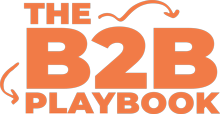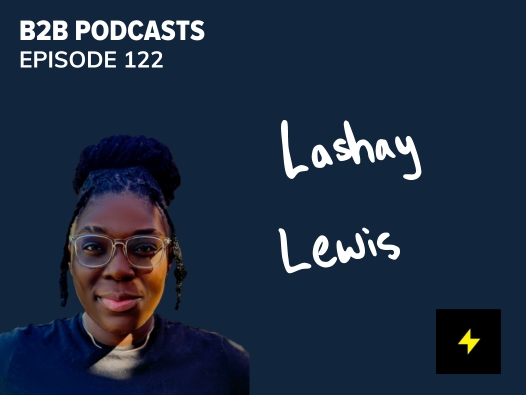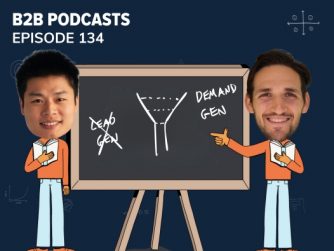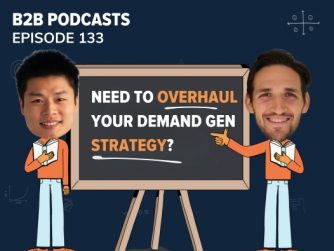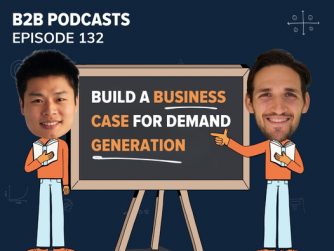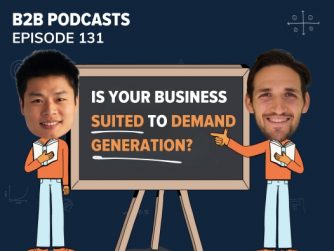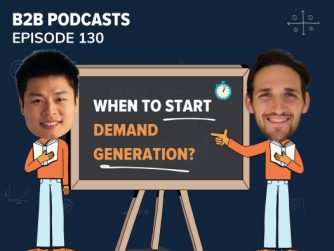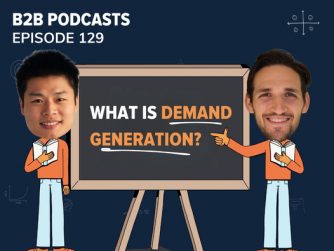The Power of Bottom of Funnel Content
When we discuss Demand Generation, we say it’s composed of two parts: creating demand AND capturing demand. Capturing demand is about making sure your business is converting the 3-5% that are currently in-market, searching for a solution like yours NOW into opportunities for sales.
To do that effectively, you need a strong Bottom of Funnel Content strategy!
If you want to learn how to create your own Bottom of Funnel Content strategy that drives pipeline and revenue, you can watch, listen or read the main points from our conversation with BoFU expert Lashay Lewis (founder of Authority Plug) below.
Listen To The Episode
Watch The Episode
What is Bottom of Funnel Content (BoFu)?
Bottom of the funnel (BOFU) content targets people who are nearing a purchase decision and actively researching solutions to their specific needs. They are much further along in their buying journey. This is in contrast to top of funnel content that aims to introduce brands and problems to unaware audiences.
(P.S. if you want more information on matching content to different stages of the buying journey, check out our favourite framework for creating demand – the 5 Stages of Awareness)
The key benefit of developing BOFU content is the outsized revenue impact it can deliver. This type of content answers the precise questions and comparisons that prospects search for when they are close to making a choice. Even keywords with relatively low monthly search volume can drive a highly qualified audience ripe for conversion.

By researching the terms and questions people search when ready to buy, you can create highly tailored content that positions your product as the ideal solution. Focusing on properly matched pain points, features, and benefits also builds trust and credibility with readers.
Why You should Focus on BoFu Content First
So why should you focus on BoFu content before other upper funnel content? Well-executed bottom funnel content allows you to intercept prospects who have already been warmed up by your brand, or even your competitors. If the visitor is informed enough to be comparing solutions so granularly, your content has the opportunity to sway them in the final stretch.
“What’s more important is how many terms can you find where the intention is to purchase something”
Lashay Lewis – The B2B Playbook – [12:10]
Also, because you are targeting people deeper in the buyer’s journey, bottom of funnel content can help shorten sales cycles. That means instead of trying to take cold leads through early education stages, your sales team can focus on qualified prospects much closer to a purchasing decision. This increases marketing’s impact on driving pipeline and opportunities.
In a nutshell, prioritizing bottom of funnel content unlocks Conversion opportunities otherwise left on the table – you can capture instead of just create demand. The high level of intent also leads to better engagement metrics and sales team alignment.
Follow a Proven Framework for High Converting Bottom Funnel Content
When structuring your bottom of funnel content, it’s important to follow a proven framework that has been shown to convert readers.
When you boil it down, Lashay points out that there’s really only 6 core elements that need to be included in your BoFu content. They are:
- Pain points
- Identify the top issues and challenges your potential customers face
- What problems motivate them to seek out a solution?
- Source these directly from sales call notes and customer research
- Benefits
- How specifically does your product address those high priority pain points?
- Outline the concrete benefits customers receive from key features
- Focus on the outcomes users care most about
- Features
- What functionality enables and delivers those benefits?
- Provide enough technical insight to showcase capabilities
- But keep explanations understandable
- Comparisons
- Draw credible contrasts between your product and alternative options
- Readers likely already self-educated on competitors
- Show where your solution excels relative to other offerings
- Case Studies
- Share specific examples of how target customer segments apply your product
- Helps readers picture using your software for their needs
- Include metrics or testimonials that back up success
- Examples
- Where helpful, provide screenshots, videos, or tutorials
- Makes capabilities more tangible
- Boosts engagement and comprehension

Great BoFu content combines these elements in a compelling way.
Core Components: Match Pains to Benefits to Features
A key part of structuring effective bottom of funnel content is connecting at a granular level your product features to the specific benefits they deliver to address major pain points. As Lashay says:
“Taking your customer’s most dying pain points… Talk to the sales team, they have the answers to those questions. Once you find out those dying pain points, that’s when you start to match those up to benefits of your product and then you start to match those benefits to features of your product.”
Lashay Lewis – The B2B Playbook – [00:20:41]
This means reaching out to customer-facing teams like sales and support to uncover not just general challenges or user problems, but the most pressing pains they repeatedly hear during research and calls. Lashay asserts that sales staff “are going to have the answers to those questions” identifying the severity or intensity of common pain points.
We also recommend that you speak directly to the customer where you can (and here’s Ryan Gibson’s guide for Customer Interviews!).
You then methodically map those high-priority customer problems to specific benefits from your product/tools that remedy or prevent those issues from happening – or at least minimise their impact. Demonstrate how your product or service was custom built to address the exact concerns and motivations causing users to seek out solutions. Finally, showcase the technical features enabling those benefits to concretely solve for the original acute pain points.

The goal is demonstrating a direct through line from highly impactful user challenges all the way to detailed product capabilities.
Optimize Your Content for Customers First, Google Second
When assembling the components of bottom funnel content, the customer experience must come first before trying to appease search algorithms. Or as Lashay succinctly states, “The customer should be first, and SEO should be second.” [00:16:50]. If the content genuinely addresses reader questions and issues, search performance will follow.
This means taking an outside-in approach that focuses first on addressing actual questions and concerns that prospects have rather than shoehorning in keywords. Lashay doubles down on this point, explaining:
“I’ve never had a problem ranking because I’m focusing on the customer. It’s never a fight of, Ooh, should I make this SEO optimize or should I make it about the customer? It’s always going to be about the customer first.”
Lashay Lewis – The B2B Playbook – [00:17:08]
If you provide truthful, relevant help for questions potential buyers are searching, algorithms will recognize and reward that value. But in the quest for search performance, it’s easy to lose sight and overload content with forced keywords that degrade the experience.
Lashay’s core point is that by prioritizing reader help above all else, you inherently create content optimized for both human and machine. Focus on customers first, and visibility will follow not the other way around. Google is pretty smart and will reward you for great content.
And remember – for BOFU content, conversion and comprehension triumph over raw traffic metrics. Deliver what matters most to prospects first and foremost.
Prioritize Helpfulness Over Volume
Again, don’t get distracted by keywords with higher monthly search volume if they are not highly intent-driven. As Lashay points out, helpfulness and serving customer needs converts more readers than targeting wide interest topics. Provide value first, and the rewards will come.
Speak to Concerns from Sales Calls
We touched on this a little earlier in the piece, but to properly understand customer questions and pain points – you should conduct customer interviews or listen in on sales calls. That’s where the gold is! Sales and support teams speak daily to prospects and can outline the true issues they want addressed before buying. Use these insights to guide your content.
How To Drive Leads with your BoFu Content
Now let’s talk about where to send your BoFu traffic, and how to measure it to see if it’s working.
Send BoFU Traffic to Sales
By reaching the bottom of the funnel, these individuals already have significant education on the product category. Now they expect direct engagement to address their specific use case and remaining questions:
“They’re not expecting to read your piece and read: What is sales enablement software?” Don’t route them backwards.
Lashay Lewis – The B2B Playbook – [00:19:17]
Also, do not send these prospects to an email list, or a webinar.
Do not send them anywhere else but to the sales team or to book a demo.

Bottom of the funnel content should directly route traffic to make contact with sales teams – not top of funnel nurture programs.
How To Track and Measure the Success of Your BoFu Content
Because bottom funnel content drives such qualified traffic, focus heavily on monitoring downstream actions that move the business forward.
The goal of these pages is to get someone to book a demo or send them to sales, so you’ll want to track metrics like:
- Number of demo bookings / sales meetings
- Marketing Qualified Leads (MQLs), and how many of these progress to opportunities (SQOs)
- The conversion rate of page views to demo bookings/sales meetings
- The amount of time spent on page
- How far down the page the user scrolled
- Number of times the page has been viewed
Make It Easy to Showcase Revenue Impact
In a more qualified lead scenario, illustrating the revenue influence from content performance is far more achievable:
“Nothing satisfies more than showing a 10 search volume term drove 4 demos!”
Lashay Lewis – The B2B Playbook – [00:49:50]
Making this data available in a dashboard that’s easily accessible is so helpful when keeping track of it yourself, and to show to stakeholders.
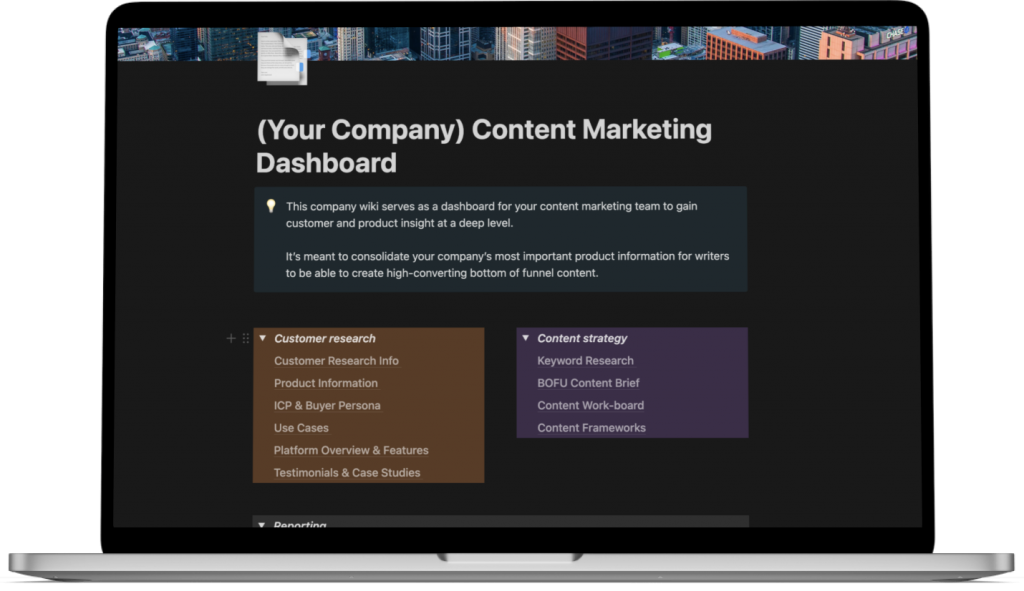
How Long Will It Take To See Results From BoFu Content?
When implementing a high-intent bottom of funnel content strategy, how soon can you expect to see meaningful traction? According to Lashay, experience shows common patterns in the timeline:
“Typically the bottom of funnel piece will be ranking within 30 days. Usually like 30 days or so after that, it starts to get traffic. Things start to pick up, and another 30 days to 60 days after that, it starts to convert.”
Lashay Lewis – The B2B Playbook – [00:36:56]
So in approximately 60 days you can aim to achieve ranking, then subsequent visibility, and in 90 days first conversions. As Lashay notes, in the beginning SEO is a loss leader but compounds over time – so while quantifiable impact takes a few months, once established the effects persist and grow exponentially years into the future if content remains relevant. Set proper expectations, but stay consistent.
I highly encourage you to both check out Lashay Lewis on LinkedIn where she shares so much of her BoFu knowledge. AND make sure you grab a copy of her free Content Marketing Dashboard here!
